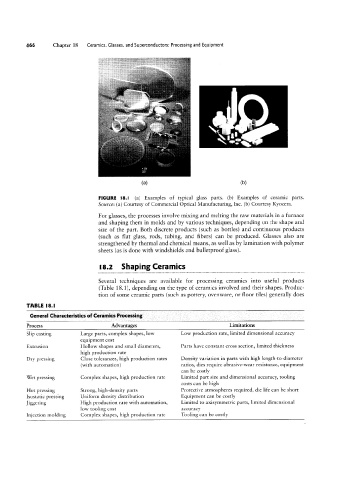Page 486 - 04. Subyek Engineering Materials - Manufacturing, Engineering and Technology SI 6th Edition - Serope Kalpakjian, Stephen Schmid (2009)
P. 486
466 Chapter 18 Ceramics, Glasses, and Superconductors: Processing and Equipment
(2) (D)
FIGURE |8.l (a) Examples of typical glass parts. (b) Examples of ceramic parts.
Source: (a) Courtesy of Commercial Optical Manufacturing, Inc. (b) Courtesy Kyocera.
For glasses, the processes involve mixing and melting the raw materials in a furnace
and shaping them in molds and by various techniques, depending on the shape and
size of the part. Both discrete products (such as bottles) and continuous products
(such as flat glass, rods, tubing, and fibers) can be produced. Glasses also are
strengthened by thermal and chemical means, as Well as by lamination with polymer
sheets (as is done with Windshields and bulletproof glass).
l8.2 Shaping Ceramics
Several techniques are available for processing ceramics into useful products
(Table 18.1), depending on the type of ceramics involved and their shapes. Produc-
tion of some ceramic parts (such as pottery, ovenware, or floor tiles) generally does
TABLE |8.I
General Characteristics of Ceramics Processing
Process Advantages Limitations
Slip casting Large parts, complex shapes, low Low production rate, limited dimensional accuracy
equipment cost
Extrusion Hollow shapes and small diameters, Parts have constant cross section, limited thickness
high production rate
Dry pressing Close tolerances, high production rates Density variation in parts with high length-to-diameter
(With automation) ratios, dies require abrasive-Wear resistance, equipment
can be costly
Wet pressing Complex shapes, high production rate Limited part size and dimensional accuracy, tooling
costs can be high
Hot pressing Strong, high-density parts Protective atmospheres required, die life can be short
Isostatic pressing Uniform density distribution Equipment can be costly
jiggering High production rate with automation, Limited to axisymmetric parts, limited dimensional
low tooling cost accuracy
Injection molding Complex shapes, high production rate Tooling can be costly

